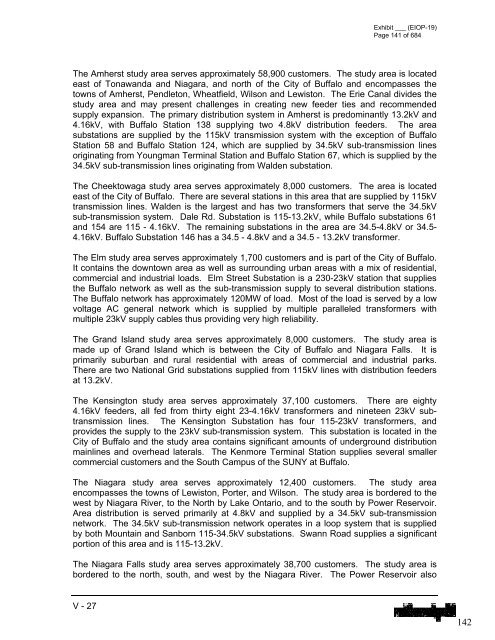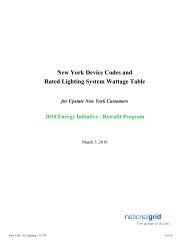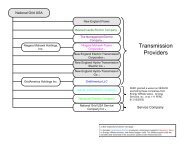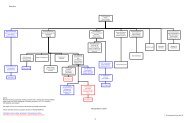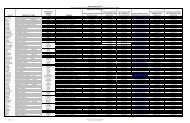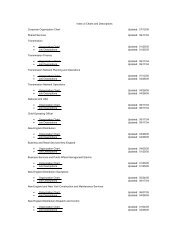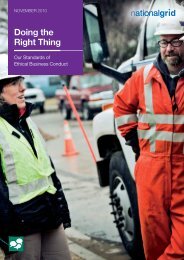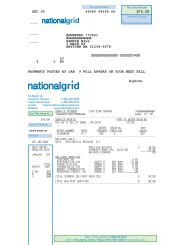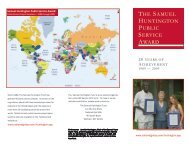January 2012 Capital Investment - National Grid
January 2012 Capital Investment - National Grid
January 2012 Capital Investment - National Grid
You also want an ePaper? Increase the reach of your titles
YUMPU automatically turns print PDFs into web optimized ePapers that Google loves.
Exhibit ___ (EIOP-19)Page 141 of 684The Amherst study area serves approximately 58,900 customers. The study area is locatedeast of Tonawanda and Niagara, and north of the City of Buffalo and encompasses thetowns of Amherst, Pendleton, Wheatfield, Wilson and Lewiston. The Erie Canal divides thestudy area and may present challenges in creating new feeder ties and recommendedsupply expansion. The primary distribution system in Amherst is predominantly 13.2kV and4.16kV, with Buffalo Station 138 supplying two 4.8kV distribution feeders. The areasubstations are supplied by the 115kV transmission system with the exception of BuffaloStation 58 and Buffalo Station 124, which are supplied by 34.5kV sub-transmission linesoriginating from Youngman Terminal Station and Buffalo Station 67, which is supplied by the34.5kV sub-transmission lines originating from Walden substation.The Cheektowaga study area serves approximately 8,000 customers. The area is locatedeast of the City of Buffalo. There are several stations in this area that are supplied by 115kVtransmission lines. Walden is the largest and has two transformers that serve the 34.5kVsub-transmission system. Dale Rd. Substation is 115-13.2kV, while Buffalo substations 61and 154 are 115 - 4.16kV. The remaining substations in the area are 34.5-4.8kV or 34.5-4.16kV. Buffalo Substation 146 has a 34.5 - 4.8kV and a 34.5 - 13.2kV transformer.The Elm study area serves approximately 1,700 customers and is part of the City of Buffalo.It contains the downtown area as well as surrounding urban areas with a mix of residential,commercial and industrial loads. Elm Street Substation is a 230-23kV station that suppliesthe Buffalo network as well as the sub-transmission supply to several distribution stations.The Buffalo network has approximately 120MW of load. Most of the load is served by a lowvoltage AC general network which is supplied by multiple paralleled transformers withmultiple 23kV supply cables thus providing very high reliability.The Grand Island study area serves approximately 8,000 customers. The study area ismade up of Grand Island which is between the City of Buffalo and Niagara Falls. It isprimarily suburban and rural residential with areas of commercial and industrial parks.There are two <strong>National</strong> <strong>Grid</strong> substations supplied from 115kV lines with distribution feedersat 13.2kV.The Kensington study area serves approximately 37,100 customers. There are eighty4.16kV feeders, all fed from thirty eight 23-4.16kV transformers and nineteen 23kV subtransmissionlines. The Kensington Substation has four 115-23kV transformers, andprovides the supply to the 23kV sub-transmission system. This substation is located in theCity of Buffalo and the study area contains significant amounts of underground distributionmainlines and overhead laterals. The Kenmore Terminal Station supplies several smallercommercial customers and the South Campus of the SUNY at Buffalo.The Niagara study area serves approximately 12,400 customers. The study areaencompasses the towns of Lewiston, Porter, and Wilson. The study area is bordered to thewest by Niagara River, to the North by Lake Ontario, and to the south by Power Reservoir.Area distribution is served primarily at 4.8kV and supplied by a 34.5kV sub-transmissionnetwork. The 34.5kV sub-transmission network operates in a loop system that is suppliedby both Mountain and Sanborn 115-34.5kV substations. Swann Road supplies a significantportion of this area and is 115-13.2kV.The Niagara Falls study area serves approximately 38,700 customers. The study area isbordered to the north, south, and west by the Niagara River. The Power Reservoir alsoV - 27142


